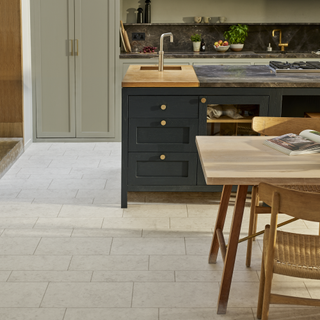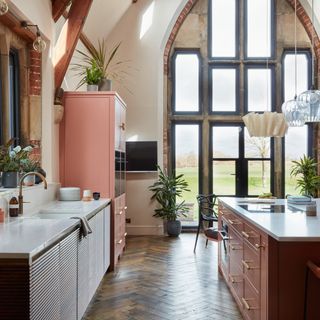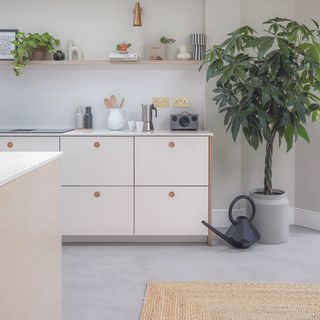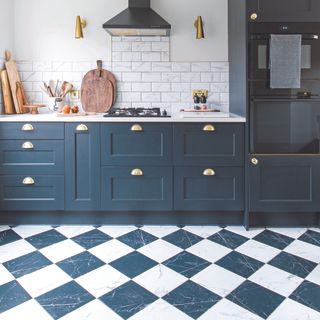Want to know the best floor colors for a small kitchen? Just because your space is small doesn't mean your floors have to be boring. You might be tempted to go for solid, simple colors to enhance the sense of light and space (which isn't a bad thing), but if you want a little more vibrancy, knowing the best floor colors for a small kitchen can add interest and enhance the sense of space.
The kitchen is the most used area in any home, so practicality is key. But your kitchen flooring ideas should also coordinate with the rest of the room, including the style and color of your kitchen units. Try to balance the colors of your floors, cabinets, and walls for a harmonious kitchen plan.
best floor colors for small kitchens
“It's best to think about what element will be the visual focal point,” explains Gavin Smith, marketing director at Karndean Designflooring.
“For example, a herringbone, chevron or abstract patterned floor can create an interesting base, while complementary cool, neutral or warm tones on the walls and units can create a calming balance. Alternatively, if the units are statement pieces or other key elements, such as marble worktops, are the focal point, a more subdued floor with a less patterned look can allow these elements to take centre stage.”
To help you decide what will suit your space, we asked kitchen flooring experts for their tips on choosing the best floor color for a small kitchen. Here are their answers…
1. Light floor colors

(Image courtesy of Amtico)
“If you're decorating a small space, opting for light colours will make your kitchen appear larger and brighter,” says Carly Greening, creative product manager at The Floor Room. “They also allow natural and artificial light to bounce around the room, creating a visually larger space.”
“Luxury vinyl in light colors like soft beige, cream and taupe can mimic the look of natural materials, while also being easy to maintain and long-lasting,” she added.
Consider the amount of natural light your small kitchen receives. If you have lots of natural light, you can choose cooler tones, but if your kitchen has only one small window or no windows at all, softer warm tones can make your small kitchen appear larger. Light wood flooring is a good option, but you can also look for porcelain tile that replicates the look of wood or warm stone, or easy-to-install click-fit laminate options.
“One of my favourite tips is to choose designs with few joins and joints, which works well when using light wood-look planks. Soft colours work beautifully with lighter wood knots and grains, creating a sense of continuity, especially when used in an open-plan layout,” says Carly.
2. Dark floors

(Image courtesy of Chris Snook Photography for The Main Company)
Generally speaking, a “less is more” approach works well in small kitchens, but don't be afraid to go bold: Sometimes a bold hue can be just the color trick you need to make a small kitchen seem bigger.
“The secret to success is to successfully mix and match different elements in your kitchen with complementary colours, patterns and textures,” says Gavin. “You might think that dark floors would make a small kitchen look cramped, but in fact using bold colours on all surfaces can work really well and create a cosy feel. Dark washed walls and units, for example, look gorgeous against a rich, aged wood or charcoal stone design.”
In addition to artificial lighting ideas for your kitchen, think about the natural lighting in your space. It's important to balance dark floors with bright daytime lighting. The darker the floor, the more light it will absorb rather than reflect. You don't want your kitchen to feel dark and cramped.
“Of course, there are dark colours to choose from,” says Habas. “A jet black Nero Marquina tile will have a totally different effect than a dark grey wooden plank tile and can make a room look longer.”
Dark flooring in a small kitchen is ideal for family homes as it allows lighter coloured furniture to stand out and is also great for hiding imperfections and minor stains.
3. Grey flooring for small kitchens

(Image courtesy of Future PLC)
“In rooms with plenty of sunlight, a cool grey design will complement neutral and playful tones,” says Gavin. These hues can be found in a variety of materials, including wood, stone, porcelain, vinyl and laminate.
Pale grey floors keep your kitchen bright and airy, perfect if you prefer a contemporary style.
Want to make a room feel bigger? “Match your grout to the color of your kitchen tiles,” says Abbas. “This works especially well with our modern Reflect tiles, whose precision edges mean smaller grout gaps between tiles. This removes visual interruptions and makes the floor feel like one seamless finish.”
4. Patterned floor in a small kitchen

(Image courtesy of Future)
There are two important things to remember when introducing pattern into a small space: scale the pattern appropriately to the size of your kitchen, and avoid combining too many different colors or complex patterns, which can create visual confusion.
“Consider small to medium-sized patterns that are proportionate to the size of the room,” Carly explains. “Luxury vinyl, in particular, is a great choice for kitchen floors because it comes in a variety of patterns, is durable, and is easy to clean. From classic checkerboard designs to Moroccan motifs, there are options for every style of décor.”
Abbas adds: “Opting for a Victorian-style checkerboard floor or terrazzo tiles will help your floor stand out without looking too cluttered.”
The pattern will also be determined by the flooring method you choose.
“The orientation of the floor can create the illusion of space by emphasising the width or length of a room, while diagonal patterns can trick the eye to make a room appear larger,” explains Gavin.
“If a herringbone or chevron pattern is desired, traditional 9″ x 3″ parquet tiles, 18″ x 3″ herringbone or 17″ x 3.5″ chevron are ideal for small kitchens. Many people also turn to geometric patterns to create a sense of depth and drama or to disguise an oddly shaped room,” he says.
FAQ
What flooring is best for your kitchen?
Hard floors are a great choice for the kitchen – consider materials such as wood, laminate, stone or porcelain tile, vinyl, polished concrete or resin for a very sleek and contemporary look.
Luckily, these types of hard flooring come in hundreds, if not thousands, of color, size, pattern and texture options, so you can find the perfect option for your space. Many porcelain tiles today replicate the look and feel of real wood, stone or marble, but with the added benefit of being cost-effective. With the durability of man-made tile, porcelain is completely waterproof, stain resistant and highly crack-resistant, so it will look its best for years to come.
When it comes to caring for your floors, it's important to think about the maintenance and how much time and effort it will take. Vinyl, porcelain tile, and laminate flooring are generally easy to care for, while natural materials like stone and wood will require more care over the years. And because the kitchen is a place that gets wet, choose materials that are highly water-resistant.
How to choose kitchen flooring
Let's start with practicality. Make sure the material, colour and pattern you choose suits your lifestyle. Can your floor withstand lots of foot traffic? Can it withstand muddy feet and kids running around? Can it be easily cleaned and hide stains so you don't waste time worrying about its condition?
Next, think about your personal style: “Our homes are an expression of our personalities, so the best advice I can give to interior designers is to choose a style that reflects your personality and lifestyle,” says Gavin.
“For inspiration, we recommend searching Instagram, Pinterest or our website and creating a mood board of ideas. Then use our room visualiser to explore different floor designs before ordering samples to see how colours will perform in your specific lighting conditions.”
“My final piece of advice is to choose timeless designs that won't go out of style as your color and style preferences change.”
Which colour and pattern do you prefer?


